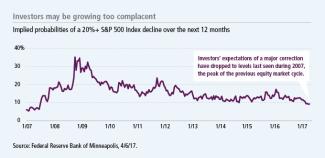
Why alternative investments may matter more than ever before
Another fine article that supports why we believe in Alternatives as Diversifiers to manage risk! **JB**
by Leo M. Zerilli, Asset Manager John Hancock Investments, CIMA
The S&P 500 Index lost 37% in 2008, an experience most market participants found hard to forget. Alternative investments—many of which are designed to manage risk—enjoyed an extensive post-crisis period of net inflows, as many investors remained wary of equities.
However, after eight consecutive calendar years of positive equity returns, interest in risk management in general and alternatives in particular seems to have cooled. In fact, investors redeemed some $11.8 billion from alternative funds over the past year.1 These outflows may be ill timed. While alternative investments play a crucial portfolio construction role in any environment, those with diversifying characteristics may prove increasingly important as equity valuations continue to stretch and investors grow more complacent.
Alternative investments have been out of favor lately
Part of the disappointment in alternatives may stem from comparisons with the broader market’s recent strength. Over the past five years, U.S. stocks posted annualized returns averaging 13.3%, handily outpacing the 1.4% that alternative investments delivered.2 Yet in emphasizing risk management, many alternative investment categories were never intended to match the return potential of traditional equities, especially over extended bull runs. Alternative investments can be as different from one another as they are from the broader market itself, but they tend to represent the epitome of skill-based active management, with relatively few constraints. Most alternative mutual fund managers seek to limit certain risks, striving for relatively consistent, rather than outsize, returns.
We highlight two types of alternatives, each of which emphasizes risk management in its own way.
- Alternative strategies, such as long/short equity, can offer investors the potential to lessen portfolio volatility while maintaining partial exposure to market appreciation. Here it’s also possible to make money from falling asset prices.
- Absolute return managers typically target positive performance independent of any benchmark. They can implement directional currency positions or relative value asset pairings aimed at exploiting changes in macroeconomic drivers, even in the absence of a rising market.
Conventional equities and bonds tend to win out—sometimes by a wide margin—when times are good for traditional investments. But times aren’t always good for traditional investments. The chief virtue of alternatives is that they don’t necessarily move in sync with the holdings that dominate many portfolios, providing investors with a source of potential upside when it’s needed most.
Alternatives are underrepresented in individual investor portfolios
The institutional investor community has embraced alternatives and their diversifying characteristics for decades. The average university endowment has allocated the majority of its portfolio—53%—to alternative strategies.3 As more alternatives have become available in mutual funds, individual investors have gained greater access to many of the same opportunities long available to institutions. Still, the evidence suggests that financial advisors and the individual investors they help don’t take full advantage of alternatives. Of the 519 model portfolios that John Hancock Investments’ portfolio consulting team analyzed, 44% held no alternative exposure whatsoever.4 Moreover, most of the remaining models maintained an insufficient allocation, in our view.
Risk management grows more important as investors grow more complacent
Investors tend to adopt a rosier outlook as asset prices rise. After an eight-year bull market, investor complacency is roughly where it was before the 2008 crisis. That’s why risk management is more relevant today. The Federal Reserve Bank of Minneapolis tracks option trading activity to report the implied probability of a major market correction; that probability has dropped to 9%, a level last seen in 2007, the peak of the last equity market cycle. Finally, it seems many of today’s investors have largely forgotten about 2008, perhaps at their peril. The role that alternative investments play in a portfolio will tend to demonstrate value at certain times and not at others. However, if the essence of investing resides in risk management, then maintaining a meaningful allocation to alternatives makes sense—especially now.

